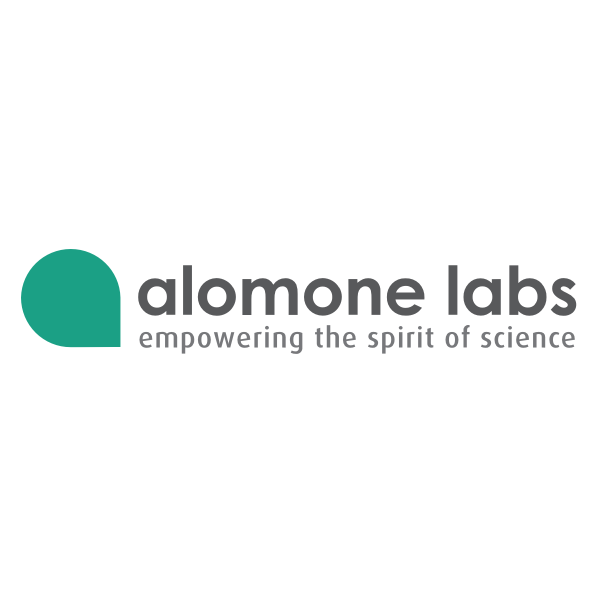 全部商品分类
全部商品分类
产品介绍
产品介绍
产品信息
纯化方式
Affinity purified on immobilized antigen.

宿主
Rabbit

免疫原
Peptide (C)KWKPSDYQGVEFMR, corresponding to amino acid residues 91-104 of rat nAChRα3 (Accession P04757). Extracellular, N-terminus.

简单描述
A Rabbit Polyclonal Antibody to Nicotinic Acetylcholine Receptor α3

商品描述
Alomone Labs is pleased to offer a highly specific antibody directed against an epitope located at the extracellular N-terminal domain of the rat nAChRα3. Anti-Nicotinic Acetylcholine Receptor α3 (CHRNA3) (extracellular) Antibody (#ANC-003) can be used in western blot and immunohistochemistry applications. It has been designed to recognize nAChRα3 from mouse, rat and human samples.

同种型
Rabbit IgG.

纯度
Affinity purified on immobilized antigen.

形式
Lyophilized

组成成分
抗蛋白抗体

基因
CHRNA3

应用
实验应用
IF, IHC, WB

反应种属
M, R

预测反应种属
H

背景
别名
nAChR α3, Neuronal acetylcholine receptor subunit alpha-3, ACHA3, PAOD2

背景
Acetylcholine, released by cholinergic neurons, activates two groups of acetylcholine receptors (AChRs); muscarinic AChRs (mAChRs) which belong to the superfamily of G-protein coupled receptors (GPCRs) and nicotinic AChRs (nAChRs) which belong to the ligand-gated ion channel superfamily. nAChRs also respond to nicotine, hence their name1.
To date, 17 different but related subunits of nAChRs have been identified and cloned. They consist of a subunits (α1-10), which is responsible for the binding of ligands. In fact, this subunit includes a Cys-loop in the first extracellular domain that is required for agonist binding2. The other subunits responsible for making up the active receptor are the β (β1-4), γ, δ and ε subunits3. Structurally, all subunits have the following: a conserved large extracellular N-terminal domain, 3 conserved transmembrane domains, a variable cytoplasmic loop and a fourth transmembrane domain with a short extracellular C-terminal domain. An active nAChR is generally a heteropentamer of these various subunits organized around a central pore1.
All α subunits are expressed in neuronal cells except for the α1 subunit which is specifically expressed in the muscle3. In the peripheral autonomic nervous system, nicotinic receptors are prominent and are responsible mediating fast synaptic transmission in all peripheral autonomic ganglia4. In this system, these channel receptors are mostly made up of two α3 subunits heteromerized with three other subunits. The α3 subunit plays a most important role in this system as knockout mice suffer from severe autonomic failure accompanied by gastrointestinal and bladder malfunctions5.
Autoimmune autonomic ganglionopathy (AAG) is a neurological disorder characterized by dysfunctions in sympathetic, parasympathetic and enteric functions. Patients suffering from the disease express high levels of self antibodies against ionotropic nicotinic receptors, namely α3 subunits4. The α3 subunit is also found in dorsal root ganglion where it is most probably involved in nociception6.
To date, 17 different but related subunits of nAChRs have been identified and cloned. They consist of a subunits (α1-10), which is responsible for the binding of ligands. In fact, this subunit includes a Cys-loop in the first extracellular domain that is required for agonist binding2. The other subunits responsible for making up the active receptor are the β (β1-4), γ, δ and ε subunits3. Structurally, all subunits have the following: a conserved large extracellular N-terminal domain, 3 conserved transmembrane domains, a variable cytoplasmic loop and a fourth transmembrane domain with a short extracellular C-terminal domain. An active nAChR is generally a heteropentamer of these various subunits organized around a central pore1.
All α subunits are expressed in neuronal cells except for the α1 subunit which is specifically expressed in the muscle3. In the peripheral autonomic nervous system, nicotinic receptors are prominent and are responsible mediating fast synaptic transmission in all peripheral autonomic ganglia4. In this system, these channel receptors are mostly made up of two α3 subunits heteromerized with three other subunits. The α3 subunit plays a most important role in this system as knockout mice suffer from severe autonomic failure accompanied by gastrointestinal and bladder malfunctions5.
Autoimmune autonomic ganglionopathy (AAG) is a neurological disorder characterized by dysfunctions in sympathetic, parasympathetic and enteric functions. Patients suffering from the disease express high levels of self antibodies against ionotropic nicotinic receptors, namely α3 subunits4. The α3 subunit is also found in dorsal root ganglion where it is most probably involved in nociception6.

制备和贮存
溶解方法
25 µl, 50 μl or 0.2 ml double distilled water (DDW), depending on the sample size.

保存方式
The antibody ships as a lyophilized powder at room temperature. Upon arrival, it should be stored at -20°C.
数据库链接
UniProt ID
P04757

研究资源识别码
AB_10687242.

声明 :本官网所有报价均为常温或者蓝冰运输价格,如有产品需要干冰运输,需另外加收干冰运输费。








 用小程序,查商品更便捷
用小程序,查商品更便捷




